Leg strength plays a huge role in our everyday lives, from walking to climbing stairs and even simply getting up from a chair. When our legs are strong, daily activities become much easier, and we maintain our independence longer. This is especially important for older adults or anyone with mobility challenges, as leg strength can significantly improve balance and reduce the risk of falls.
The good news is that you don’t need to go to a gym to strengthen your legs. Chair exercises offer an easy and effective way to boost leg strength right at home. Chair exercises are a fantastic solution for anyone looking to keep their legs strong, especially if mobility is a concern. These workouts allow you to build strength while sitting down, making them accessible for people of all fitness levels.
Whether you’re recovering from an injury or just looking to maintain your mobility, chair exercises provide a practical and convenient way to stay active. They’re perfect for those who want to keep moving but need a low-impact alternative that doesn’t require standing or additional equipment.
By incorporating chair exercises into your daily routine, you can improve your leg strength, enhance your overall mobility, and maintain your independence. It’s never too late to start focusing on your leg strength, and with just a few minutes a day, you can feel the benefits. So, why not give these simple exercises a try? They’re an easy way to stay proactive about your health and enjoy a greater sense of well-being, no matter your age or mobility level.
Benefits of Chair Exercises for Leg Strength
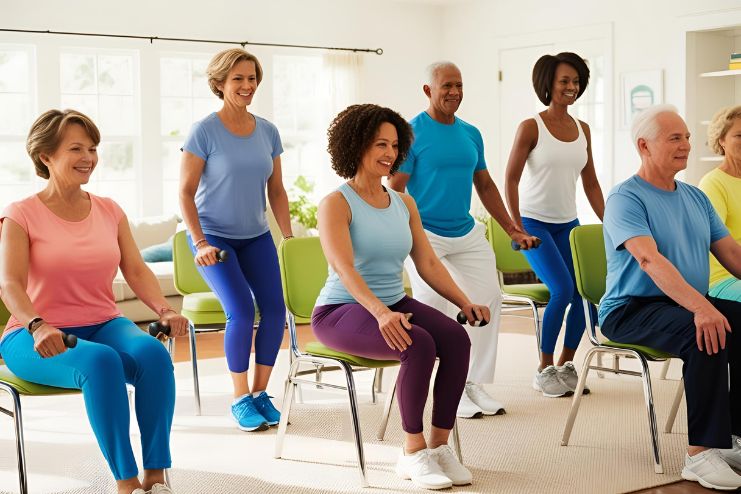
Chair exercises have become a popular and effective way to strengthen leg muscles without the need for complex equipment or intense routines. These exercises specifically target key muscle groups in the thighs, calves, and glutes, all while keeping you seated. The beauty of chair exercises is that they provide a simple, accessible way to build strength and endurance, making them ideal for individuals with limited mobility or those seeking a low-impact workout.
Chair exercises are designed to be gentle on the joints while still offering a solid workout for the lower body. Here’s how they help:
- Low-Impact Approach: Since you remain seated, chair exercises are a low-impact option that allows you to strengthen your legs without putting unnecessary strain on your joints.
- Targeted Muscle Strengthening: These exercises focus on specific muscle groups such as the thighs, calves, and glutes, helping to improve strength, endurance, and overall mobility. Even though they are performed while seated, they can still provide a full range of motion, engaging muscles that are crucial for day-to-day activities.
- Accessibility for All: The adaptability of chair exercises makes them a perfect option for people with varying abilities. Whether you’re elderly, dealing with a mobility issue, or simply looking for a more gentle workout, chair exercises can be easily modified to suit your needs.
Why Chair Exercises Are a Great Option
One of the main reasons chair exercises stand out is their inclusivity and versatility. These exercises are not only effective but also adaptable, making them suitable for a wide range of fitness levels and health conditions. Whether you’re trying to build strength, improve circulation, or maintain your independence, chair exercises provide a practical and dynamic solution.
By incorporating chair exercises into your routine, you can keep your legs strong and your body moving without the need for intensive workouts or complicated equipment. This makes them an ideal choice for anyone looking to boost their leg strength while ensuring that the exercises remain manageable and effective.
So, whether you’re just starting your fitness journey or looking for a more gentle option, chair exercises can help you achieve your goals while keeping things accessible and straightforward.
Read More: 7 Powerful Exercises to Build Strong and Sculpted Legs
Seated Leg Extensions
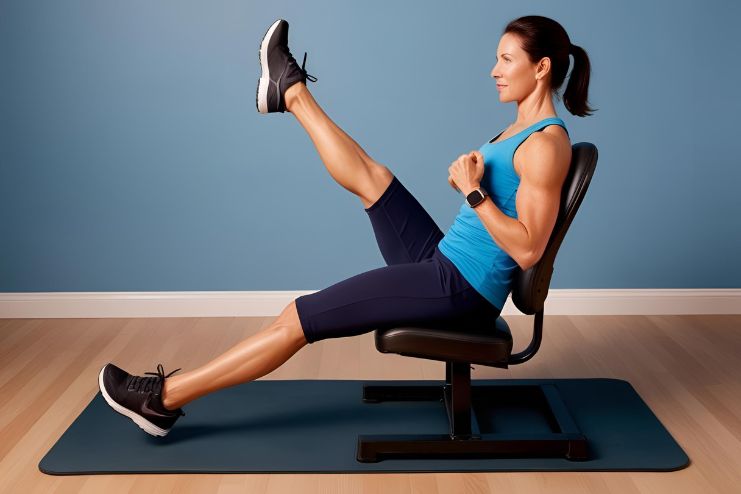
The seated leg extension is an effective exercise specifically designed to target and strengthen the quadriceps, the muscles located at the front of your thighs. These muscles are key to many everyday activities, from walking to standing up, making this exercise a great addition to any leg-strengthening routine. It’s simple to do, requires no special equipment, and can be performed comfortably while seated in a chair.
How to Perform the Seated Leg Extension
To get the most out of this exercise, follow these steps carefully:
- Start with Proper Posture: Sit on a stable chair with your back straight and your feet flat on the ground. Make sure your posture is upright to avoid strain during the movement.
- Extend One Leg: Slowly straighten one leg out in front of you, ensuring your knee is fully extended without locking it. This engages the quadriceps and helps build strength in the front of your thighs.
- Hold the Position: Pause for a few seconds while keeping your leg extended. Focus on contracting the quadriceps to feel the muscle working.
- Return to Starting Position: Slowly lower your leg back to the ground, ensuring a controlled movement. This helps with muscle activation and prevents unnecessary strain.
- Repeat on the Other Leg: Perform the same movement with your other leg. This ensures that both legs are strengthened equally.
Benefits of the Seated Leg Extension
While simple, the seated leg extension has a significant impact on your leg strength and functionality. By regularly including this exercise in your routine, you can experience the following benefits:
- Improved Knee Stability: This exercise strengthens the quadriceps, which play a key role in stabilizing your knees. Stronger quads can help reduce the risk of knee injuries and improve overall mobility.
- Enhanced Quadriceps Strength: As you repeat the exercise, you’ll build strength in the quadriceps, making daily activities like walking, standing, and climbing stairs easier and more efficient.
Incorporating seated leg extensions into your daily or weekly routine is a great way to boost leg strength without putting too much strain on your body. This simple but effective exercise can improve your overall leg functionality and help maintain mobility, especially for those with limited time or mobility concerns.
Chair Squats
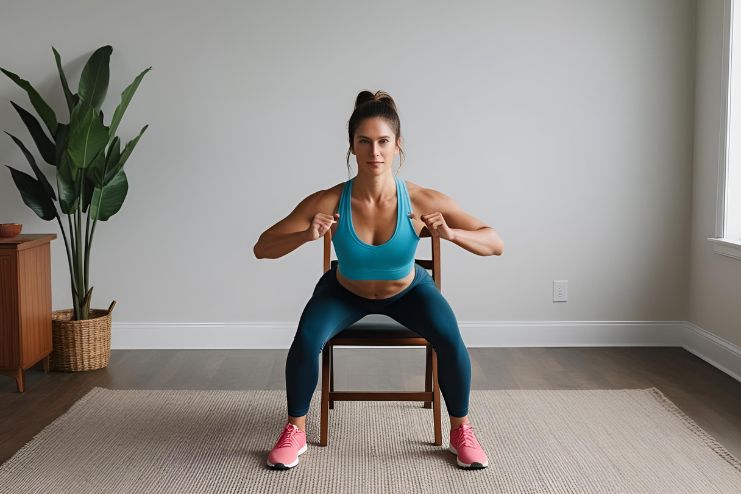
Chair squats are a fantastic exercise for building lower body strength and improving stability. They target key muscles in the legs, including the quadriceps, hamstrings, and glutes. What makes chair squats particularly beneficial is that they offer the same great benefits as regular squats but with extra support from the chair, making them an accessible option for people of all fitness levels. This exercise can help improve balance, stability, and overall lower body strength, all while minimizing the risk of injury.
How to Perform Chair Squats
To get the most out of chair squats, follow these steps:
- Set Up Properly: Stand in front of a sturdy chair with your feet hip-width apart. Make sure your knees are aligned with your ankles and your weight is distributed evenly across your heels. Keep your chest lifted and your core engaged as you prepare to lower yourself.
- Lower Into the Squat: Slowly lower your body towards the chair, imagining you’re about to sit down. Make sure your knees are tracking over your toes and not pushing forward beyond them. Your back should remain straight, and your core should stay active throughout the movement.
- Lightly Touch the Chair: As you lower yourself, let your glutes make light contact with the chair, but don’t fully sit down. This helps to engage your muscles without overloading them. The idea is to use the chair as a guide for your squat depth.
- Push Back Up: Once you’ve lightly touched the chair with your glutes, push through your heels to lift yourself back up to a standing position. Make sure you keep your core tight and your chest lifted as you rise.
Key Tips for Safe and Effective Chair Squats
To ensure you’re getting the full benefits of chair squats while minimizing the risk of injury, focus on the following:
- Proper Knee Alignment: Keep your knees behind your toes throughout the squat to avoid placing unnecessary stress on your joints.
- Maintain a Straight Back: Keep your back straight and your chest lifted to engage your core and protect your spine during the movement.
By incorporating chair squats into your workout routine, you can improve lower body strength, stability, and posture, all while promoting functional movement. This simple yet effective exercise can be easily adapted to fit your fitness level, making it a great choice for everyone.
Seated Calf Raises
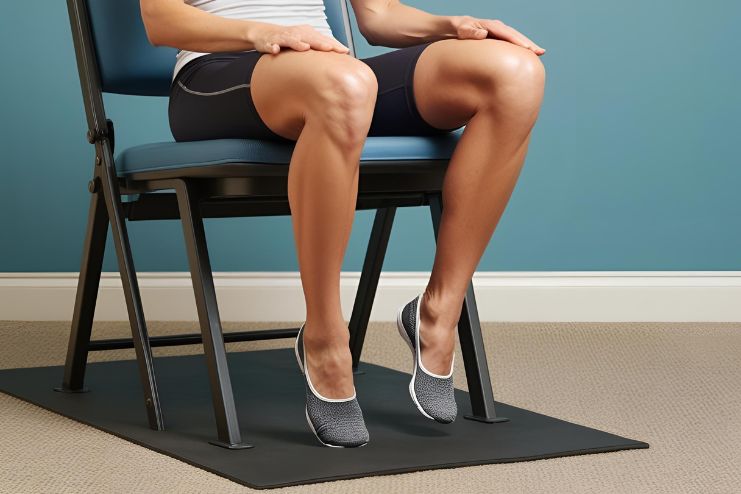
Seated calf raises are an excellent exercise for strengthening the calf muscles and improving lower leg stability, all while being performed in a seated position. This makes them an ideal option for individuals who may have difficulty standing or who prefer a low-impact workout.
Regularly doing seated calf raises not only helps develop the calves but also contributes to better ankle stability, which can enhance overall mobility.
How to Perform Seated Calf Raises
Follow these simple steps to ensure you perform the exercise correctly and safely:
- Start with Proper Positioning: Sit on a stable chair with your feet flat on the ground and your knees bent at a 90-degree angle. Keep your back straight and place your hands on your thighs for support.
- Lift Your Heels: To begin the movement, press through the balls of your feet, lifting your heels off the ground while engaging the calf muscles. Focus on a smooth, controlled movement, avoiding any jerking motions.
- Hold the Position: Once your heels are raised, hold the position for a brief moment to fully activate the calves. This brief pause helps enhance muscle engagement and builds strength.
- Lower Your Heels Slowly: Gently lower your heels back to the starting position, keeping the movement slow and controlled. Avoid letting your feet drop quickly to maintain tension in the calves.
Benefits of Seated Calf Raises
Incorporating seated calf raises into your routine offers several key benefits:
- Improved Calf Strength: By consistently performing this exercise, you strengthen the calf muscles, which play a crucial role in various daily movements, such as walking, climbing stairs, and standing.
- Enhanced Ankle Stability: Seated calf raises help improve the stability of the ankle joint, which can reduce the risk of falls and enhance overall lower leg mobility.
- Accessibility for All Fitness Levels: Since this exercise can be done while seated, it’s ideal for people with mobility issues, those recovering from injury, or anyone seeking a low-impact way to strengthen the legs.
Seated calf raises are an easy yet effective way to improve your lower leg strength, stability, and mobility. With just a few minutes each day, this simple exercise can have a significant positive impact on your overall leg health and function.
Chair Step-Ups
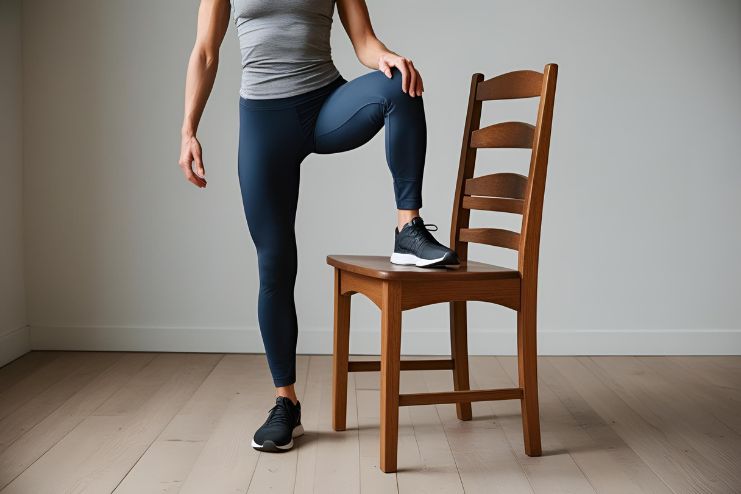
Chair step-ups are a great way to strengthen your lower body by targeting key muscles like the quadriceps, hamstrings, and glutes. This dynamic exercise not only helps build strength but also improves stability and coordination. It’s a versatile workout that can be adjusted to suit all fitness levels, making it accessible for beginners while still challenging for more advanced practitioners.
How to Perform Chair Step-Ups
Follow these steps for an effective and safe chair step-up:
- Position Yourself Properly: Stand in front of a sturdy chair, making sure it is stable and won’t move during the exercise. Place one foot flat on the chair’s seat, ensuring that your foot is centered and secure.
- Step Up and Engage: Press through the heel of your elevated foot and push your body upward, bringing your torso forward as you straighten both legs. At the top, ensure your posture remains straight and your core is engaged.
- Step Down with Control: Slowly lower your body back down to the ground by stepping back with the foot that was elevated. Bring the other foot down next to it, returning to your starting position. Maintain controlled movements throughout to avoid any jerky actions.
Variations and Progressions
Chair step-ups are easily adaptable to suit different fitness levels, and you can modify the exercise to increase or decrease its difficulty:
- For Beginners: Start by using a lower chair or platform to make the step-up more manageable. This reduces the range of motion and helps you focus on form before progressing.
- For Advanced Practitioners: To challenge yourself, increase the speed of your step-ups or add a knee raise at the top of the movement. This will engage the hip flexors and further work your core, adding an extra layer of difficulty to the exercise.
- Increasing Intensity: For a more advanced workout, you can hold dumbbells or add resistance bands to increase the intensity of your step-ups, further developing leg strength and endurance.
Why Choose Chair Step-Ups
Chair step-ups are not only effective but also highly versatile. They can be adjusted based on your fitness level, making them perfect for beginners, intermediates, or advanced practitioners. Whether you want to build strength, improve stability, or add a bit of variety to your leg workout routine, chair step-ups offer an excellent solution. They can be performed at home or in the gym, making them an easily accessible exercise for everyone.
Leg Circles
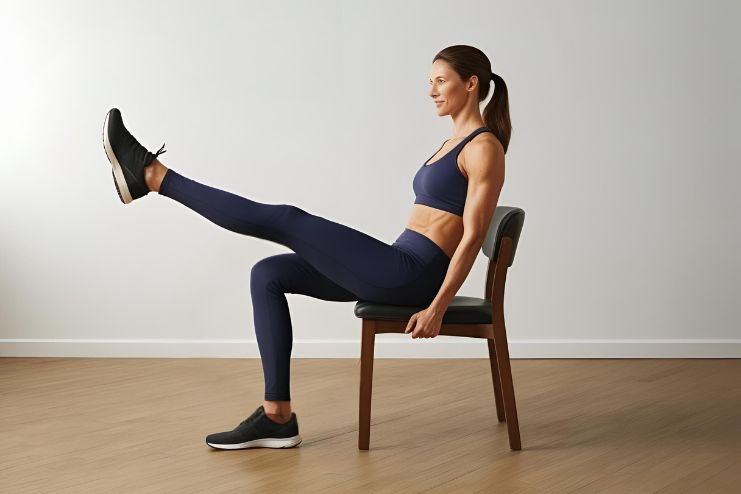
Leg circles are a simple yet effective exercise designed to enhance hip mobility and leg strength. This workout is especially useful because it can be performed while seated, making it accessible for individuals of various fitness levels. Whether you’re looking to improve flexibility, circulation, or overall lower body endurance, leg circles are a fantastic addition to your exercise routine.
How to Perform Leg Circles
Follow these steps to do leg circles properly:
- Get Into Position: Sit comfortably in a sturdy chair with your back straight and feet firmly planted on the floor. Keep your posture upright to avoid strain on your back.
- Lift One Leg: Lift one leg off the ground, ensuring that it remains straight. Keep your knee extended and engage your hip muscles.
- Draw Circles: Begin making small circles with your elevated leg. Focus on smooth, controlled movements while ensuring that your leg stays straight throughout the exercise. Keep the motion slow to target the hip and leg muscles effectively.
- Switch Legs: After completing a set of circles with one leg, lower it gently and switch to the other leg. Perform the same number of circles on this side.
Benefits of Leg Circles
Leg circles offer several benefits that can significantly improve your lower body health:
- Improves Hip Mobility: The circular motion helps improve the range of motion in the hip joint, which is important for overall flexibility and movement efficiency.
- Enhances Circulation: Since the movement is low-impact but involves the muscles of the leg, it helps stimulate blood flow and enhance circulation to the lower extremities.
- Strengthens the Legs: By engaging the hip and leg muscles during the exercise, leg circles help build endurance and strength, contributing to better lower body functionality.
Why Include Leg Circles in Your Routine
Leg circles are a great low-impact exercise that anyone can do, regardless of their fitness level. They are an ideal way to gently work the muscles, improve joint mobility, and increase circulation without requiring complex equipment or intense effort. Incorporating leg circles into your regular workout routine can promote better lower-body health, helping you stay active and mobile.
Chair Leg Press
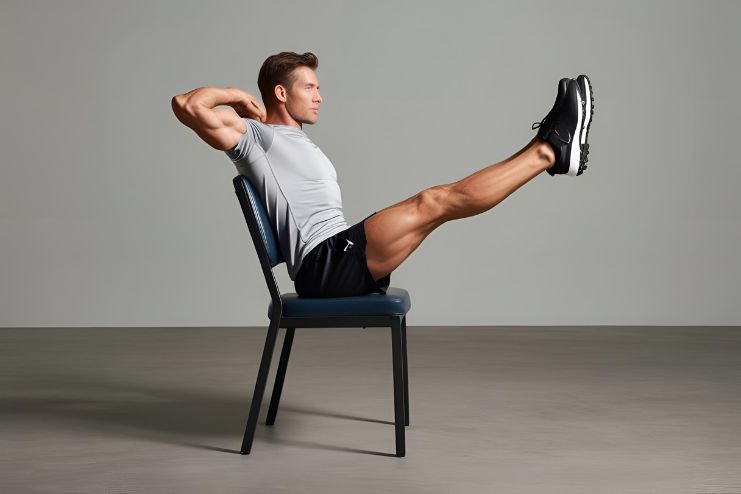
The chair leg press is a versatile exercise designed to strengthen the quadriceps and hamstrings. This exercise is particularly helpful for those seeking an accessible way to build lower body strength without needing complex equipment or complicated routines.
Whether you’re new to strength training or looking for a low-impact alternative, the chair leg press can be easily incorporated into your workout regimen.
How to Perform the Chair Leg Press
To execute this exercise correctly, follow these steps:
- Find a Stable Chair: Sit in a sturdy chair with your back straight and your feet firmly placed flat on the ground. Make sure you feel balanced and supported before you begin.
- Engage Your Core: Place your hands on the sides of the chair for additional support and to maintain your balance. Keep your posture upright and engage your core muscles to help stabilize your body.
- Extend Your Legs: Apply pressure through your heels and extend your legs straight out in front of you, focusing on using your quadriceps and hamstrings to push your legs. As you push against the resistance, ensure your movements are controlled and steady.
- Return to Starting Position: Slowly lower your legs back down to the starting position, keeping tension in your muscles to maximize the effectiveness of the exercise.
Modifying the Intensity
One of the benefits of the chair leg press is that you can easily adjust the resistance to match your fitness level. Here’s how you can modify the intensity:
- Add Ankle Weights: By adding ankle weights, you can increase the resistance, making the exercise more challenging and beneficial for muscle growth.
- Use a Resistance Band: Wrap a resistance band around your thighs to add extra tension when you press your legs forward. This provides an adjustable level of resistance that can be tailored to your needs.
Why Include the Chair Leg Press in Your Routine
The chair leg press is a fantastic addition to any workout program. Not only does it target key lower body muscles, but it also offers a customizable resistance level that allows for gradual progress as your strength improves. It’s a low-impact, effective way to enhance your lower body strength and can easily be modified for individuals of all fitness levels. Whether you’re new to exercise or a seasoned athlete, the chair leg press can provide a safe and efficient way to build strength.
Standing Chair Pose
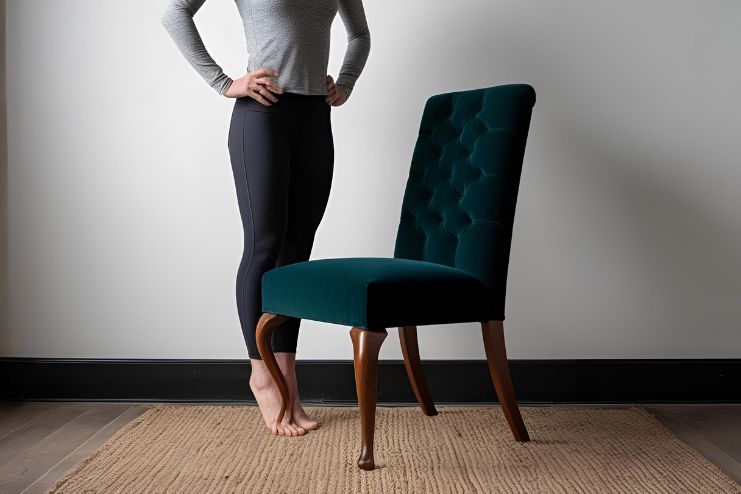
The standing chair posture is a great exercise that combines elements of yoga into a seated routine, focusing on strengthening the legs and improving balance. This simple yet effective movement targets the calves, quadriceps, and overall lower body stability, making it a useful addition to any fitness routine. Whether you’re looking to enhance your balance or build strength in your legs, this exercise is versatile and can be easily modified for various fitness levels.
How to Perform the Standing Chair Posture
- Start with a Stable Position: Begin by standing behind a sturdy chair with your feet hip-width apart. This is your starting position, ensuring that the chair is firmly placed to provide support.
- Lift Your Heels: Slowly lift your heels and rise onto your toes, keeping your weight evenly distributed. Hold onto the chair for balance as you perform this movement.
- Maintain Good Posture: Make sure your back is straight, and your core is engaged to help with balance. Keep your torso aligned and avoid leaning forward or arching your back.
- Hold or Pulse: Once you’re up on your toes, you can either hold the position for a few seconds or add short pulses by gently lowering and raising your heels. This variation will increase the intensity and benefit of the exercise.
Progressing with the Standing Chair Posture
As you become more comfortable with the movement, you can make adjustments to increase the challenge:
- Reduce Support: For beginners, the chair offers solid support, but as your balance improves, you can gradually reduce the amount of grip on the chair. This will increase the challenge to your stability.
- Increase the Intensity: For a more advanced variation, hold the raised position for a longer period or add small pulses at the top to enhance the effectiveness of the exercise. This will further strengthen your calves, quadriceps and improve your overall balance.
Why Include the Standing Chair Posture in Your Routine
This exercise is adaptable to various fitness levels, making it a fantastic choice for everyone from beginners to more experienced practitioners. The standing chair posture not only strengthens the legs but also improves lower body stability and balance.
Its simplicity and versatility allow you to customize the intensity, making it an excellent addition to any workout routine. Whether you’re working on building strength or enhancing your balance, this exercise provides a holistic approach to leg strengthening.
Cool Down and Stretching
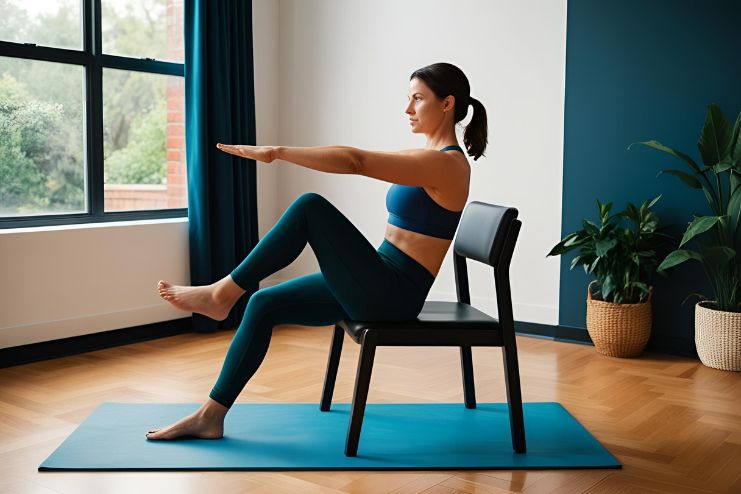
After completing your chair exercises, it’s important to follow up with a proper cool-down routine to enhance flexibility and avoid muscle stiffness. A cool-down allows your heart rate to gradually return to normal and helps clear waste products from your muscles. This post-exercise phase is crucial for recovery and maintaining overall leg health. Taking just a few minutes for some gentle stretches will not only aid in flexibility but also provide a sense of calm and help relieve any muscle tension.
Why a Cool-Down Matters
Cooling down is an essential part of any workout, including chair exercises. It allows your body to ease into a more relaxed state, prevents muscle tightness, and helps reduce the risk of injury. By incorporating targeted stretches at the end of your routine, you promote better circulation, flexibility, and overall muscle recovery.
Easy Seated Stretches to Incorporate
- Hamstring Stretches: While seated, extend one leg in front of you and gently reach for your toes. Hold the position for 20-30 seconds to stretch the back of your thigh. Repeat on the other side. This stretch targets the hamstrings and helps alleviate any tightness from lower body exercises.
- Ankle Circles: Lift one foot off the ground and slowly rotate your ankle in a circular motion, both clockwise and counterclockwise. This simple exercise improves ankle flexibility and circulation, making it particularly useful after leg workouts.
The Benefits of Stretching After Your Workout
Incorporating stretching into your cool-down routine not only improves your flexibility but also enhances your overall sense of well-being. By focusing on leg stretches, you help your muscles recover from the workout, reduce tension, and maintain mobility. Taking the time to cool down promotes a more balanced and enjoyable exercise experience, allowing you to stay active with less risk of soreness or discomfort.
Read More: How to Organize Your Leg Day at The Gym
Conclusion
Chair exercises are an excellent way to boost leg strength, improve overall mobility, and promote independence. They are also incredibly practical and accessible. Whether you’re doing seated leg extensions or standing chair poses, these exercises target key muscle groups like the quadriceps, hamstrings, and glutes.
They’re perfect for anyone, regardless of fitness level, and are especially beneficial for those with limited mobility. The beauty of chair exercises lies in their inclusivity—everyone can participate and see progress. Incorporating chair exercises into your routine doesn’t just strengthen your legs; it also improves balance and flexibility.
These exercises allow you to work on your leg strength without putting unnecessary strain on your joints, making them a great option for people of all ages. Plus, the accessibility of chair workouts means you can do them at home at your own pace, making it easier to stay consistent. By adding chair exercises to your regular fitness routine, you’re not just working towards stronger legs; you’re also investing in your overall health and well-being.
They help you build the confidence to stay active and independent, no matter your fitness level or physical limitations. So, start incorporating these exercises today and take the first step towards healthier, more mobile legs—and a more active, fulfilling life.
-
Feb 2024Written by Ankita
-
May 2025Edited by Shreya
References
- https://www.multicare.org/vitals/the-hidden-benefits-of-chair-exercises
- https://betterme.world/articles/chair-exercises-for-legs
- https://www.self.com/gallery/chair-exercises
- https://www.verywellfit.com/leg-extensions-benefit-or-risk-3498573
- https://www.signos.com/exercise/leg-extension-guide
- https://www.menshealth.com/fitness/a28008112/leg-extensions
- https://www.masterclass.com/articles/leg-extension-guide
- https://greatist.com/fitness/chair-squats
- https://www.healthline.com/health/fitness-exercise/leg-exercises-for-bad-knees
- https://workoutlabs.com/exercise-guide/chair-squats
- https://www.strengthlog.com/seated-calf-raise
- https://www.inspireusafoundation.org/seated-calf-raises
- https://www.nestacertified.com/standing-calf-raise-vs-seated-calf-raise
- https://www.livestrong.com/article/13769454-step-up-exercise/
- https://www.mayoclinic.org/healthy-lifestyle/fitness/multimedia/step-up/vid-20084661
- https://www.verywellfit.com/weighted-step-up-exercise-3120001
- https://www.pilatesanytime.com/exercise-view/1427/video/Pilates-One-Leg-Circle-by-Amy-Havens
- https://www.verywellfit.com/how-to-do-one-leg-circle-2704673
- https://www.signos.com/exercise/leg-press-guide
- https://www.verywellfit.com/how-to-do-the-leg-press-3498610
- https://www.menshealth.com/fitness/a42443953/how-to-leg-press
- https://www.yogajournal.com/poses/5-ways-to-strengthen-your-chair-pose
- https://yogauonline.com/yoga-practice-teaching-tips/yoga-practice-tips/4-chair-pose-variations-to-improve-strength-and-balance
- https://www.masterclass.com/articles/awkward-chair-pose
- https://www.acefitness.org/about-ace/press-room/in-the-news/8260/the-importance-of-stretching-and-cooling-down-after-an-intense-workout-health-news
- https://www.mayoclinic.org/healthy-lifestyle/fitness/in-depth/exercise/art-20045517
- https://www.ncbi.nlm.nih.gov/pmc/articles/PMC5999142/
In this Article




![Best NAD+ Supplements for Energy, Aging, and Cellular Health [2025 Edition] Best NAD+ Supplements for Energy Aging](https://www.healthspectra.com/wp-content/uploads/2025/05/Best-NAD-Supplements-for-Energy-Aging-218x150.jpg)














